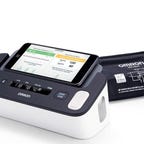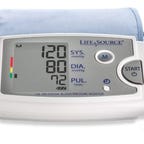Best smart blood pressure monitor
Withings BPM Connect Wi-Fi Smart Blood Pressure Monitor
View details

Best blood pressure monitor with EKG
Omron Complete Wireless Upper Arm Blood Pressure Monitor + EKG
View details

Best blood pressure monitor for larger arms
LifeSource Upper Arm Blood Pressure Monitor With Extra Large Cuff
View details
Blood pressure is one of the simplest health metrics to keep track of, and it can tell you a world about your cardiovascular health and risk of heart attack or stroke.
The good news? You don’t need to wait until your next doctor’s appointment to get a reading. By investing in a blood pressure monitor to keep at home, you can monitor trends in your blood pressure over time and or potentially catch signs of hypertension or other heart health problems.
To help you in your search, we narrowed down a few quality models and asked cardiologists for insight on tracking your blood pressure at home.
Who should be tracking their blood pressure?
Ideally, everyone should, according to Dr. Mary Branch, a cardiologist at Cone Health in Greensboro, North Carolina.
“Blood pressure is a good overall measure of health, so really anyone can,” Branch said. She added that some people may feel blood pressure is only something to worry about when you’re older, but it’s important to establish a baseline when you’re younger, along with other basic health metrics like A1C (an average blood sugar metric that screens for diabetes) and lipids (insight into cholesterol).
While anyone who’s been recommended to track blood pressure regularly should do so, such as those diagnosed with hypertension, other populations may be at higher risk of potentially dangerous conditions involving high blood pressure and may benefit from more home monitoring.
Branch advised anyone planning a pregnancy to start tracking their blood pressure because of the risk of preeclampsia, which is a serious and potentially fatal condition involving high blood pressure during pregnancy. Similarly, those who had high blood pressure during pregnancy should track it after birth, in the months postpartum, Branch advised.
What should you watch for while monitoring your blood pressure at home?
Blood pressure is read with two numbers: systolic (the top number, which tells you the pressure your arteries are under with each heart beat) and diastolic (the bottom number, which indicates how much pressure your arteries are under between beats). Only a doctor can diagnose you with hypertension or chronically high blood pressure, but monitoring at home can clue you in that your measurements may be higher than normal and cue you to reach out to a doctor, who can help you get to the bottom of it or manage your heart health. (It’s important to note that any blood pressure reading above 180 systolic — top number — or 120 diastolic, is considered a hypertensive crisis and you should seek medical care immediately.)
But monitoring your blood pressure can give you other clues about your heart health. Dr. Mustali Dohadwala, medical director of Heartsafe in Boston, said that “erratic” blood pressure readings, meaning those that are significantly lower or higher morning to night, or even minute to minute, can indicate an irregular heartbeat such as atrial fibrillation. Some models of blood pressure monitors have irregular heart beat detection or EKG built in.
On the other hand, lower-than-normal blood pressure can also be detected through home monitoring.

This chart from the AHA gives different categories of blood pressure readings and what yours may mean.
How we chose the best blood pressure monitors
Along with a handful of other monitors, the Withings, LifeSource and Omron Complete with EKG models went through hands-on testing in 2019. Based on factors such as consistency, brand credibility and accuracy, these models remain solid choices today. The Omron 3 series was added in 2024 based on cardiologist preference for the brand in addition to its affordability.
The Withings BPM Connect feels trendy, and it provides a consistent and accurate result. For the upper arm cuff fit, comfort and ease of use, the Withings BPM Connect holds its own. The app is also a breeze once you’re in, and it has unlimited storage for your BP measurement needs (although the device will remember only up to eight readings in between syncs). You can also set up multiple user profiles in the Withings Health Mate app, which is a plus if you have multiple people in a household that want to track their blood pressure.
The Omron Complete Wireless Upper Arm Blood Pressure Monitor with EKG was the first FDA-approved combination EKG-blood pressure device in the US. Omron produced the product in partnership with AliveCor, which powers many FDA-approved consumer electrocardiogram (EKG or ECG) devices.
Worth mentioning is that this blood pressure monitor gave the most consistent readings throughout the entire testing process. It measures so much more than just blood pressure. In addition to the essentials — systolic and diastolic blood pressure — this Omron model measures your pulse, atrial fibrillation, tachycardia, bradycardia and sinus rhythm simultaneously.
If you need a seamless way to measure two or more of those metrics, this upper-arm monitor is a top choice. The Omron app interface is simple, and it can store unlimited data. The cuff is comfortable and flexible, making it easy to get a good fit, which helps with accuracy.
The monitor itself is a little bulkier than other models but probably worth it for people who need all those other measurements in one place. It comes in a nice carrying case that you can use for traveling.
The Omron 3 Series is one of the more affordable blood pressure monitors out there, and importantly, it’s one you can also feel confident has been clinically validated.
Omron also appears to be a favorite brand among the cardiologists we spoke with. Dr. Trent Orfanos, director of integrative and functional cardiology at Case Integrative Health, said he recommends Omron as a brand patients should consider when shopping for an at-home blood pressure monitor. He said he doesn’t usually “spell out a model,” but that he likes the Omron brand as it has many clinically validated models listed on validatebp.org.
The Omron 3 Series appear to be an older and more affordable model than other blood pressure machines by the company. The 3 Series can store up to 14 blood pressure readings, which you can transfer to the Omron connect app. Users wanting to share a blood pressure monitor with another household member, or those requiring one with more memory, would be better suited by another Omron model.
If you have larger upper arms, you know that not all arm monitors fit comfortably, making blood pressure management and monitoring a huge pain. Enter the LifeSource Upper Arm Blood Pressure Monitor With Extra Large Cuff; this blood pressure cuff accommodates an arm circumference of a bit more than 23 inches.
There didn’t seem to be a lot of information about this one online, but LifeSource is a brand of A&D Medical, a medical equipment brand that’s been manufacturing at-home consumer devices for close to 50 years. Despite being tested on a smaller arm in 2019, it did produce consistent readings. Although the blood pressure level readings were wrong in our tests, they were consistently wrong. That gave hope that this extra-large cuff is indeed accurate for the people it actually fits.
It has a memory capable of storing 60 readings, which is in line with many blood pressure monitors in this price range, and better than some of the cheaper models.
Right now, the AHA doesn’t recommend using a finger or wrist blood pressure monitor. All three of the doctors we spoke with said people should avoid buying a blood pressure monitor that measures from the wrist.
“The wrist cuffs tend to be inaccurate,” Orfanos said. “They tend to exaggerate the blood pressure,” he added, meaning readings may be higher than they really are.
- Size of your arm: What’s a good fit, cuff-wise, for a larger arm might not be the best fit for a smaller one, and vice versa. Measure the circumference of your arm before you purchase a cuff and monitor to make sure it’ll suit your needs.
- Other heart conditions: Some devices may provide other health metrics, like pulse rate, or detect other health conditions, like irregular heartbeat.
- Clinical validation: This means the device has gone through testing that satisfies medical standards. The easiest way to check your blood pressure monitor has been clinically validated is to look for one listed on validatebp.org.
- Bring it into your doctor’s office for a test run: If you have hypertension and want to keep tabs on your blood pressure at home, it’s a great idea to bring in your blood pressure monitor to your doctor’s office so you can measure your cuff against theirs, making sure readings are aligned and that you’re measuring properly.
The AHA has a few tips for you to keep in mind before and during your blood pressure reading. For the most accurate results, you should:
- Avoid caffeine, smoking or exercising within 30 minutes of taking your blood pressure
- Empty your bladder and rest for 5 minutes before the reading
- Sit correctly with your feet flat on the floor, your back straight and supported, your arm resting on a flat surface
- Make sure you’re not measuring over clothing, including shirtsleeves
- Don’t talk or carry on a conversation while taking your blood pressure
- Secure the cuff directly above the bend of the elbow and check your monitor’s specific instructions
- Measure at the same time every day
- Take two readings per day, about 1 minute apart
High blood pressure is called the “silent killer” because there are often no obvious signs you have it.
According to the AHA, some symptoms are inconclusively related to high blood pressure, such as dizziness, facial flushing and blood spots in the eye. This means that they may occur in people with high blood pressure, but that they aren’t necessarily caused by blood pressure.
If you’re experiencing very high blood pressure — typically 180/120 or higher, according to the World Health Organization — you may have symptoms, and you should consider this a medical emergency. Call for help and get medical care right away.
According to the WHO, symptoms of emergency-level blood pressure can include:
- Severe headaches
- Chest pain
- Dizziness
- Difficulty breathing
- Nausea
- Vomiting
- Blurred vision or other vision changes
- Anxiety
- Confusion
- Buzzing in the ears
- Nosebleeds
- Abnormal heart rhythm






